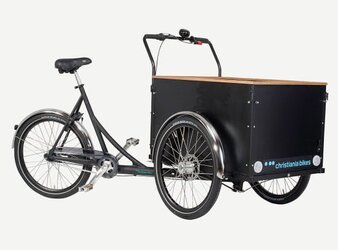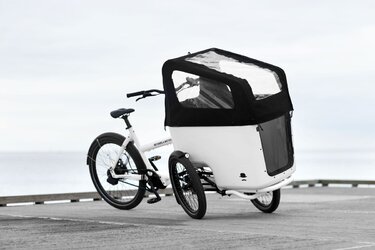Pedropete
Guru
- Location
- West Sussex, UK
An introduction to cargo bikes
Feel free to reply with additions or corrections and I'll edit as needed.Q. What are cargo bikes?
A. Cargo bikes are designed and built to carry heavier and/or larger loads than might be carried easily or safely on more conventional bikes*.
* While cargo racks, panniers and baskets can be added to most bikes, their performance, handling and even safety can suffer as a result. The design, materials, strength and rigidity of conventional bikes - incl. wheels and other components - simply aren’t designed for the additional loads of purpose-built cargo bikes. Another effective way of turning almost any bike into a cargo bike is to add a cargo trailer**.
** See separate thread on cargo trailers.
TYPES OF CARGO BIKE
Cargo bikes can be broadly grouped into three main categories based on the number of wheels they have, with further sub-categories and electrically-assisted and non-assisted versions within each. While three and even four-wheeled designs are common they are all still commonly referred to as cargo ‘bikes’.
A note about e-cargo bikes (electrically-assisted) vs non-assisted cargo bikes
Many cargo bikes are available as conventional (non-assisted) and electrically-assisted versions (‘e-cargo bikes’) but manufacturers are increasingly removing non-assisted versions from their ranges due to falling demand and the greater margins available on e-cargo bikes. Increased demand is driven by the greatly enhanced utility of e-cargo bikes, ie. it makes them more usable for more people when carrying heavier loads and offers a more compelling alternative to cars or even light commercial vehicles for most users.
Obvious down sides of this trend are the increased cost of purchase & maintenance for e-cargo bikes, and reduced choice for those who would prefer conventional non-assisted options, e.g. those living in mostly flat areas who may not need assistance or those who would prefer to purchase a non-assisted cargo bike and then add their choice of after-market pedal-assist system to it. The latter option offers a significant cost saving - for both initial purchase and out-of-warranty repair costs - and avoids potential technology dead-ends inherent to proprietary drive and battery systems where bikes are designed specifically for those systems and cannot be readily converted to use alternatives.
______________________________________2-WHEELED
Long-tails, mid-tails and compacts
A mostly conventional bike layout but with a stretched rear-triangle (back end) and added options for carrying loads (people or objects/materials). Generally featuring extended rear cargo-decks, side running-boards and over-sized panniers (bags) or load-slings. Hard-mounting points for optional fixed front racks/baskets are also common and offer increased carrying capacity, particularly when the rear load area is occupied by passengers.
Some designs use a smaller (20") rear wheel in order lower the rear cargo area and improve low-speed stability, while others, such as Tern’s ‘GSD’ and Bicicapace's 'Justlong', use smaller wheels at front and rear to shorten the wheelbase and make bikes easier to manoeuvre and store in modern residential properties. Some bikes feature 24" wheels as a compromise, i.e. to reduce the bike's footprint and improve low-speed stability while maintaining some of the improved rolling resistance of larger wheels.
An alternative form is the ‘low-tail’, with a flat load area or bucket positioned between rider and rear wheel; examples include the Maderna ‘Truck’ and Mike Burrow’s ‘8Freight’.
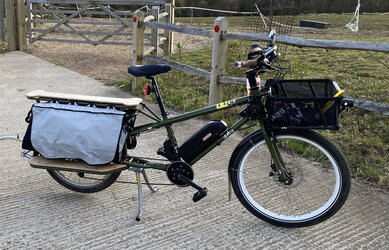
Long-tails
- Fisher: ‘Transport’ (discontinued in 2015)
- Kona: ‘Ute’ and ‘E-Ute’ (arguably more ‘mid-tail’ but both now discontinued)
- Maderna Cycle Systems: ‘Truck’
- RadPower ‘RadWagon 4’ [UK]
- Yuba: 'Mundo', 'Spicy Curry' [UK]
[UK] = known distribution/availability in the UK at time of writing
Mid-tails
- Benno: ‘Boost’ [UK]
- Kona: ‘Minute’ (also now discontinued)
- Riese & Muller: ‘Multicharger’ [UK]
- Yuba: ‘Kombi’ [UK]
[UK] = known distribution/availability in the UK at time of writing
Compact long-tails
[UK] = known distribution/availability in the UK at time of writing
Bakfiets, boxbikes or longjohns
The classic Dutch bakfiets, or 'box bike' (aka 'longjohn' in North America) is what many think of when discussing cargo bikes. And, while 'Bakfiets' is a brand in its own right the name is largely synonymous with this style of bike. The load/passenger area is in front of the rider with the rider sitting over a rear wheel (as with conventional bikes) and steering the smaller front wheel (usually 20") by means of either a push/pull-rod or cable* mechanism connected to the handlebars. The passenger/load area is generally either an open-topped box with seats for child passengers or a flat cargo area or box; most manufacturers offer a range of optional tents/weather-covers for both passengers and cargo.
*Cable-steering offers improved manoeuvrability but requires more frequent servicing and adjustment.
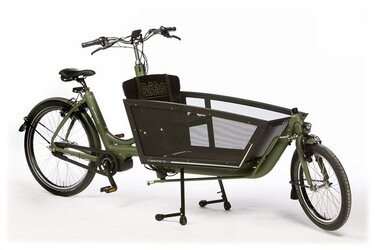
- Babboe: various models [UK]
- Bakfiets: various models [UK]
- Ca-Go [UK]
- Cube: ‘Cargo Hybrid’ [UK]
- Gazelle: ‘Makki' [UK]
- Yuba: ‘Supermarche’ [UK]
[UK] = known distribution/availability in the UK at time of writing
Butcher bikes and front-loaders
These bikes fit the archetypal image of the classic British butcher's bike or the Hovis bakery bike etc. They generally have a standard size rear wheel and either a large rack over the front wheel (often combined with a hinged parking stand) or a smaller front wheel with an even larger rack mounted above it.
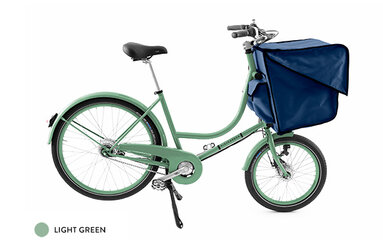
- Bergamont: 'E-Cargoville Bakery'
- Bicicapace: 'Classic', 'Classicona', 'Pelican' [UK]
- Pashley: ‘Delibike’ [UK]
- Ridgeback ‘Butcher’ [UK]
[UK] = known distribution/availability in the UK at time of writing
General utility and work bikes
These are largely conventional bikes but engineered to carry slightly heavier loads and with greater versatility. Often featuring additional mounting points for racks/baskets and room for larger /heavier panniers. A classic example of the type is Pashley's 'Pronto'; adapted to become Royal Mail's long-serving 'Mailstar' postie-bike and later refurbished by the Cycle of Good project and sold as the Elephant Bike.
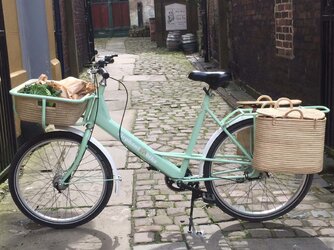
[UK] = known distribution/availability in the UK at time of writing
______________________________________________________________________________3-WHEELED
1F:2R (1 wheel at front, 2 wheels at rear)
Commonly known as ‘tricycles’ or ‘trikes’. The load area is located to the rear of the bike between the two rear wheels. The rider sits in front of the load-area and steers with direct linkage to the front wheel, as with conventional 2-wheeled bikes. Drive-power is transmitted to the rear wheels.
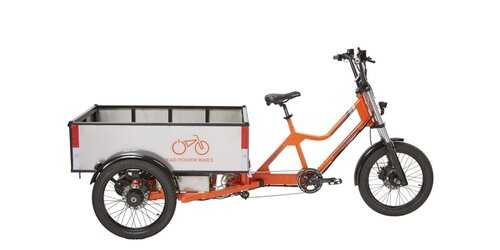
- Cycles Maximus: modular cargo & passenger trikes
- Gleam: leaning trike
- ONOMOTION: ONO - commercial development platform
- Pashley: ‘Loadstar’ [UK]
- Radwagon: ‘RadBurro’ (discontinued)
[UK] = known distribution/availability in the UK at time of writing
2F:1R (2 wheels at front, 1 wheel at rear)
Known simply as ‘3-wheelers’ and the most common 3-wheeled cargo bike layout. The rider sits over the rear wheel and behind the load-area/box which is located between the two front wheels. Power is supplied directly to the rear wheel as with conventional bicycles. Steering is achieved in one of two ways:
Articulated frame
The load area or box sits directly on/over the front axle and between the front wheels. Handlebars are connected directly to the load area/box and turning them causes it (load-area/box) and wheels to turn together, pivoting around a connection to the rear frame and wheel. This is the classic layout seen for decades (over a century) in 3-wheelers and is still in common use.
- Babboe: various models [UK]
- Pashley: ‘Classic No.33’ [UK]
[UK] = known distribution/availability in the UK at time of writing
Linkage-steering
The front wheels turn independently of the box/load area and are linked to each other (as with a car); steering is achieved with a push/pull steering linkage connected to the handlebars. Some examples allow the bike to lean into turns, improving handling and stability at speed.
- Chike: eponymous- compact, leaning
- Mastretta: various models; leaning, focus on towing capacity
- Nihola: various models [UK]
- Urban Arrow: ‘Tender’ [UK]
[UK] = known distribution/availability in the UK at time of writing
______________________________________________________________________________4-WHEELED
4-wheelers are being increasingly adopted by commercial users: from couriers and last-mile operators to online grocery delivery services, trade service providers and even for passenger transport. Notable recent developments are Occado and ASDA's adoption of EAV’s ‘2cubed’ platform for grocery deliveries in larger towns and cities.
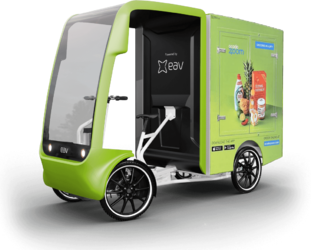
- CityQ
- EAV: ‘2cubed’ and other development platforms - modular commercial platform [UK]
[UK] = known distribution/availability in the UK at time of writing
Again, feel free to reply with additions or corrections and I’ll add/edit as needed.
Last edited:

